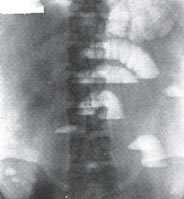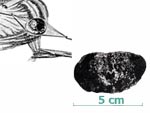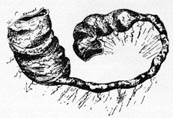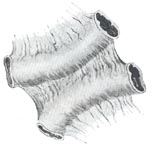INTESTINAL OBSTRUCTION IN ADULTS
Rolf Zelmanowicz, MD., Gastroenterology.
Report of our 17-year medical experience in Gastroenterology, in which we have participated in the treatment of 500 adult acute abdomen cases, of which 80% had intestinal obstruction.
Intestinal obstruction is the partial or total interruption of transit of the alimentary bolus through the intestinal tract.
Main mechanical causes
The main causes for occurrence of intestinal obstruction are:
| Adhesions (chiefly in individuals that have already undergone abdominal surgery); | ||
| Inflammation (peritonitis, Crohn's disease) | ||
| Tumors | ||
| Invagination |
 |
|
| Volvulus/ twisting of loops of intestine | ||
| Bilious calculus (bilious ileus) | ||
| Bezoar (foreign bodies) | ||
| Postoperative (complications) | ||
| Worms (Ascaris) | ||
| Abdominal herniae (internal and external) | ||
| Diverticulitis | ||
| Radiation-induced enteritis | ||
| Traumatisms | ||
| Spastic ileus | ||
| Non-mechanical causes | ||
| Paralytic (adynamic) ileus, which has different clinical causes | ||
| Acute mesenteric ischemia | ||
| Metabolic disorders | ||
| Lead poisoning (saturnism) | ||
Clinical characterization of intestinal obstruction
The initial characteristic of an intestinal obstruction is an abdominal distension caused by accumulation of swallowed air (several daily litters), food and digestive apparatus secretions- comprised of saliva, gastric, pancreatic, bilious and intestinal fluids – which can amount up to six to eight daily litters.
Therefore, food, swallowed air and secretions together, while not absorbed in the low portions of the intestine, won't be able to perform the normal intestinal transit and, consequently, will dilate the intestine, leading to a dramatic scenery of acute abdomen, known as intestinal obstruction.
This condition may be sudden or insidious, primarily depending on:
| if the intestinal lumen was completely or partially closed | ||
| if it happened suddenly – cases of twisting of the bowel, also called volvulus or strangulated hernia – or if it occurred gradually, as in postoperative adhesion cases, or due to tumors |  |
|
Diagnosis
The differential diagnosis of intestinal obstruction, despite being complex and multidisciplinary, is relatively easy to achieve by a physician knowledgeable in acute abdomen, due to the unique characteristics of the struggle between the loops and the obstacle.
It's important to take action before the onset of fecaloid vomits, which are symptoms of obstruction in the low intestinal loop (distant from the stomach).
With a simple stethoscope used at abdominal examination, the physician can hear, at the same time, the patient's complaint due to colic pain (intensive, crampy pain) and the characteristic sound -the borborygmus, the rumbling noise of fluids passing – which makes it different from bilious and renal colic, where the unique sound of bowel twisting is not present.
Initially, menstrual colic and the possibility of ectopic pregnancy, imminent miscarriage, etc. must be ruled out. This data must also be looked at during the radiological examination.
Acute intestinal infections, in which there's also presence of colic, are not associated to intensive abdominal distension, usually with diarrhea. Even in partial obstructions, when elimination of feces and gases may occur, the intestinal loop becomes more distended than usual as a result of air-fluid accumulation.
When the obstruction is not caused by a mechanical factor, as in the case of mesenteric artery infarction (the artery that irrigates the intestine), despite the abdominal distension, in the clinical finding, colic and rumbling sounds through the intestinal lumen won't be noticed at examination – it's the so called adynamic ileus. This is associated to a very severe condition owing to vascular suffering.
There's another adynamic ileus condition, which is quite rare, caused by a metabolic disorder resulting from lack of potassium.
A few situations take part in the differential diagnosis; for instance, myorcardium infarction, acute pancreatitis and herpes zoster, with strong abdominal pain and gas in the colons; in these, however, the characteristic air-fluid noises of the struggle of the bowel against the obstacle are absent. The diagnosis is comprised of tests, symptoms and signs, which guide the clinical treatment.
When the mechanical obstructive condition causes vascular suffering, as in the case of volvulus (twisting of the bowel) or strangulated hernia, the patient's general status is quickly aggravated.
In intestinal obstruction there's great endogenous (internal) dehydration due to fluid accumulation in the intestine.
Intestinal obstruction may occur at any age and gender. Mortality rate may range from 2% to 25% and is related to delay in obstruction removal. Partial obstructions allow us to evaluate for a longer time the best measure to take. These represent more than 50% of obstructions and most can be treated without surgical intervention. Other conditions allow us to place the patient in a better clinical status for a less risky surgical intervention.
Therefore, a differential diagnosis can be achieved by a physician with experienced hearing and with adequate examinations. The clinical examination is imperative – examinations only support the diagnosis.
X-ray examination
This examination may be performed in a hospital or even in a simpler facility by a trained technologist and then interpreted by a physician, if no radiologist is available.
It was scientifically proven that all the air in the small intestine is simply swallowed air.
The action of bacteria on non-digested food forms gas in the large intestine.
In a few hours after the obstruction, there's air enough (dark area) to allow its viewing on radiographs.
The examination that supports the clinical diagnosis is the simple abdominal radiography, with the patient in an upright position (standing up).
At this position, we can identify the fluid levels, which are easily viewed. By interpreting the localization of the fluid levels below the dark areas, we can arrive at conclusions and identify the obstructed region, as the loops above this region will be dilated, full of fluids and gases. The loops of intestine below the obstruction will be shrunk.
As the intestines, the jejunum, the ileum and the colons have different morphological features, an experienced physician will observe that the accumulated gases draw the walls of these organs. With these signs, he can determine the possible obstruction site; for instance, if the occlusion is high or low. They also allow identifying whether the occlusion is partial or total. In total obstruction, no air is found in the colon and rectum. Fluid levels in the same loop, at different heights, demonstrate a mechanical obstruction (struggle of the loop). When these levels are at the same height, they indicate adynamia, that is, paralytic ileus. Ultrasound and magnetic resonance imaging must be used in case of doubt in the interpretation of simple abdominal radiographs. Likewise, over the last years abdominal laparoscopy has been a useful aid in the hands of experienced endoscopists.
Ultrasound and magnetic resonance examinations must be used in case of doubt in the interpretation of simple abdominal radiographs.
In our clinical experience, we've had the chance to describe a sign of total occlusion, which we call "necklace sign", with the simple verification of small pearl-shaped amounts of residual gas in shrunken loops of intestine (after the obstruction).
The possibility of extra-intestinal gas due to hollow viscus perforation (stomach and intestine) must always be ruled out. To do so, an x-ray examination must be performed. The patient lies down in lateral position, and a simple abdomen radiograph is taken with horizontal rays. If there's even a small amount of gas in the abdominal cavity, the gas will tend to go up and draw, with a sharp shadow, the upper and lateral portion of the abdomen, between the abdominal wall and the membrane involving the viscera (peritoneum). That's air outside the viscera, and the logical conclusion is that there's a perforation, which may occur, for instance, when a perforated ulcer results in peritonitis.
The use of contrasts – barium- in addition to leading to controversial results, impairs the interpretation of air-fluid levels, thus the patient, especially with upper obstruction, vomits the content, and in case of a patient presenting lower obstruction in the small intestine, the contrast takes too long to arrive at the place.
Barium will only be indicated for lower obstruction in cases of colon and rectum obstructions.
Fighting delay is our main goal; therefore, in our experience, the use of barium does nothing but impairs the emergency diagnosis.
At the same time that the diagnosis is confirmed, the patient is subjected to clinical conditions:
| with a nasogastric probe for decompression of the upper digestive tract; | |
| with adequate compensation of the hydro-electrolytic imbalance. |
Based on our experience and on a recent literature research, we understand there's room for the use of long intestinal probes, particularly in upper jejunum obstructions, when the duodenum (1st portion of the intestine) is also subjected to swelling.
As the duodenum has a singular irrigation in its wall, this situation causes suffering, aggravating the clinical status.
The new techniques of enteroscopy help place the long probe into the upper portions of the intestine. 
Next, if the obstruction is total, we proceed to traditional surgery or laparoscopy.
It is unclear which the best method is – laparoscopy or laparotomy (traditional surgery). We feel that laparoscopy would be the first choice in most obstruction cases, provided that suitable screening is performed and the surgeon knows the benefits and limitations of this technique. However, we know that in many a case this will have to be converted into a traditional abdomen surgery.
Surgery in an intestinal obstruction patient, carried out by a physician experienced in emergencies, is highly likely to succeed in relieving such dramatic event.
Obstructions associated with peritonitis are always treated with abdominal cavity rinsing for cleaning the infection in this cavity, in addition to obstruction removal. The peritoneum (membrane covering the intestine) defends itself in a better way when acting against the aggressor agent throughout its surface.
We always had doubts as to the use of drains in the abdominal cavity following its extensive rinsing, in peritonitis cases. The benefit of draining was small when compared to the great risk of taking an infection from the outside to the inside. Therefore, this risk-benefit equation would have us recommend not using drains.
We've never found an intestinal perforation exclusively due to swelling of bowel loops.
Intestinal obstructions with vascular suffering are hastily referred to resection (removal) of the affected bowel loop.
Some particularities in an intestinal obstruction condition.
Bilious calculus (bilious ileus) 
Bilious calculus is a bulky stone that causes inflammation in the wall of the gall bladder and reaches the neighboring organ – the intestine. With the course of this inflammation, a perforation of the viscera takes place. The stone, while traversing the intestine tract, moves on until the intestine lumen becomes smaller than the stone size, or it seats at the ileocecal valve (passage between the small and the large intestines).
This process causes a total or intermittent obstruction.
Bezoar
Bezoar is a concretion made of hair or vegetable fibers, which is formed in the stomach. On becoming bulky, it may move on through the intestine and lead to intestinal obstruction.
We had the chance to check this kind of occurrence in 11 cases.
These foreign bodies can be removed off the intestine easily, and, many times, their removal is a reason for rejoicing, since they're more commonly found in the elder suspected to have malignant tumors.
Spastic ileus
We've found this curious condition twice: it's a 10-15-cm intestinal segment in permanent shrinkage, in which the simple procedure of causing the pre-obstruction stagnated fluids to move on is enough to put an end to the shrinkage. 
Saturnism
We've also witnessed a curious saturnism case caused by the ingestion of conserve-stored partridge presenting gun lead. The symptoms remind us of mechanical obstruction colic.
The patient presented a wooden belly (abdominal defense, with abdominal rigidity to palpation), yet there was no intestinal occlusion.
Adhesions
Adhesions are bands found 50-95% of the time, according to statistics from respected medical centers, in smaller or greater amounts, following traditional abdominal surgery or laparoscopy.
They're responsible for a great number of intestinal obstructions and also for their relapse, it remains unclear which one of the 2 intervention methods (laparoscopy or traditional surgery) leads to a smaller occurrence of these bands.
It's worth remembering that, after the obstruction is emptied out, the after-occlusion intestine must be carefully examined, as more than one occlusion may exist in the after-obstruction loops, and this fact may go unnoticed during the operation.
In an attempt to avoid relapse and with the obstruction being already removed, we introduced the method of carefully passing the stagnated fluids in the pre-obstruction loops to the after-obstruction loops.
This procedure is useful for:
| checking the likely presence of adhesions and the lysis of these and other obstructions; | |
| the stagnated fluid is known to be non-toxic, and though there's some absorptive difficulty due to venous stasis in the intestinal walls, the patient would be hydrated with his/her own stagnated fluids. |
How are adhesions formed?
Thrombin and fibrinogen together, in the fluid of the abdominal cavity, form a protein called fibrin, which constitutes bands of adhesion, formed within 2 days. On the (serous) intestinal wall surface, it acts as glue, binding neighboring structures, which is a kind of inconvenient scar tissue formation. 
What do we expect?
This "glue" binds the dilated loops, without clusters, angulations, forced or compromised positions.
Actually, we don't "prevent" further adhesions, they'll be formed on surfaces with longer and wider bands, allowing, thus, freer movement once the loop returns to its normal size and status. Thereby, instead of the occurrence of a scar tissue formation that narrows, encloses or entraps the loops, there'll be a wider and looser band of adhesion allowing freer movements in the intestine, avoiding inadequate and dangerous bindings.
In our findings, we felt there were fewer obstructive relapses caused by adhesion, after surgery and the use of this method.
However, we didn't have the chance to undertake a controlled study.
The best treatment will be an association of:
| a conservative clinician who, concerned with the patient's general status, looks for the best moment for surgery or who is able to avoid it; |
Most cases of well-evaluated partial occlusion can resolve with clinical treatment, using probes for decompression, especially when the condition is caused by adhesion.
Finally, it's important to stress that the fearsome knotting and twisting of the bowel is highly likely to resolve when properly treated under the right conditions.